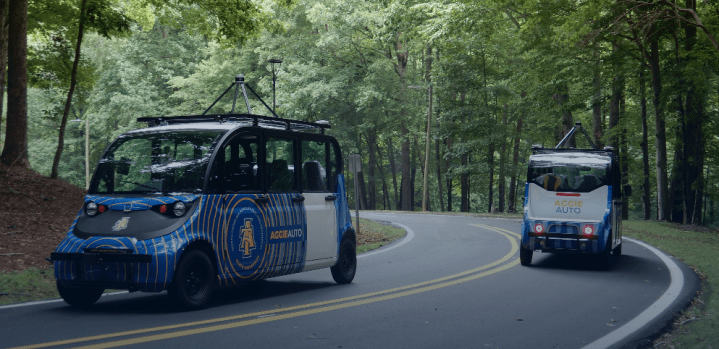
University looks to self-driving shuttles to transport students
University looks to self-driving shuttles to transport students

It all started with an idea for a senior design project. Daniel Tobias was an undergraduate at North Carolina Agricultural and Technical State University in Greensboro.
“I woke up one day and I was like, ‘Yeah, I kind of want to do a small-scale [remote-control] car,” Tobias said.
Tobias said he was getting bored writing papers at the lab where he worked. So, for the project, he convinced his research director to let him make an RC car one-tenth the size of an average car.
After graduating in 2017, he moved to Detroit to work in the auto industry with Fiat Chrysler Automobiles. Then, he came back as a graduate student at the historically Black university, studying data science at NC A&T.
“It’s been a very rewarding, I would say, career path,” Tobias said. “You get involvement in mechanical aspects, electrical and computer science.”
And now, on campus at his alma mater, Tobias is working on an autonomous shuttle for students.
Standing beside a two-mile rural Autonomous Vehicle test track, Tobias and other members of the team are just outside the garage door that leads to the autonomous vehicle lab.
Some researchers are analyzing 3D modeling for the path the AVs took on a recent test run. Others are zip-tying loose wires, which attach light sensors that help generate the vehicle’s view of its environment.
The lab has a whiteboard, desks and computers on one half of the room, and in the other half: six autonomous vehicles.
Professor Ali Karimoddini leads the research and helped Tobias with that first project. He said the team has four golf cart-like shuttles it’s preparing for students.
“Lower speed vehicles for, let’s say campus, downtown and so on,” Karimoddini said. “We also have higher speed vehicles that are more appropriate for longer distance travel, let’s say highways and some other areas.”
The goal is to build shuttles that will transport students for the pilot program — and maybe Greensboro residents one day — but also serve as a model for communities.
“Our focus is in public transportation and the way that we can develop autonomous vehicle technology for public transportation,” Karimoddini said.
In fall 2023, they’re hoping to launch four six-passenger shuttles to take students around campus and downtown.
The team is working with the city of Greensboro, along with the North Carolina Department of Transportation and others, to test whether this kind of project is feasible. It’s one of many similar plans in the works across the U.S.
Frank Douma co-authored a study analyzing those plans. He researches transportation at the University of Minnesota’s Humphrey School of Public Affairs.
“There are a number of states that are developing executive orders or even legalizing deployment of automated vehicles,” Douma said. “Kind of creating that sort of incentive.”
In “Autonomous vehicle policies with equity implications: Patterns and gaps,” Douma and co-authors write that autonomous vehicles could either “improve, or harm, social equity for disadvantaged groups.”
On the extremes, Douma sees two possible futures: One where AVs create a stronger transit system for all, or another where private vehicles make getting around more difficult.
There is still time to create plans that improve equity in transportation, he said.
“Developing policies to address specific inequities or underserved communities has not been really articulated in many of these policies so far,” Douma said.
Tobias, the North Carolina A&T student who just finished his graduate degree, said he wants to help solve those equity problems — starting with students at his school.
“A&T and downtown Greensboro — it’s close, but still far,” Tobias said.
And it’s not an easy walk. So, for students who don’t have cars, an autonomous shuttle could make it possible to commute to a job, buy groceries or just get lunch off campus.
There’s a lot happening in the world. Through it all, Marketplace is here for you.
You rely on Marketplace to break down the world’s events and tell you how it affects you in a fact-based, approachable way. We rely on your financial support to keep making that possible.
Your donation today powers the independent journalism that you rely on. For just $5/month, you can help sustain Marketplace so we can keep reporting on the things that matter to you.

















